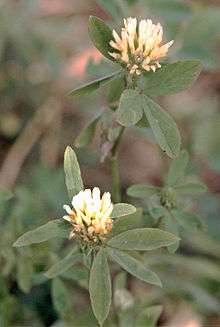Trifolium alexandrinum
Trifolium alexandrinum (Egyptian clover, berseem clover)[1] is an annual clover cultivated mostly in irrigated sub-tropical regions, and used as leguminous crop. It is an important winter crop in Egypt, where it may have been cultivated since ancient times,[2][3] and was introduced into northern India in the early nineteenth century. It is also grown in the United States and Europe.
| Trifolium alexandrinum | |
|---|---|
 | |
| Scientific classification | |
| Kingdom: | Plantae |
| Clade: | Tracheophytes |
| Clade: | Angiosperms |
| Clade: | Eudicots |
| Clade: | Rosids |
| Order: | Fabales |
| Family: | Fabaceae |
| Genus: | Trifolium |
| Species: | T. alexandrinum |
| Binomial name | |
| Trifolium alexandrinum | |
The plant reaches 30 to 100 cm (12 to 39 in) tall with erect or ascending stems. There are two types of berseem clover, single-cut and multi-cut. Single-cut varieties, like Balady, feature a high growing point and feature poor recovery once harvested. Multi-cut varieties, like Frosty, feature a lower growing point allowing for multiple harvests from a single sowing.
Berseem clover is generally frost-sensitive and should be planted only after potential for frost has passed. The exception is Frosty berseem clover which was developed by Grassland Oregon, Inc. and released in 2016. This variety is capable of surviving temperatures as low as 5 degrees Fahrenheit.[4]
Forage - Berseem clover is capable of producing up to 8 tons of forage in a single growing season.[5] Berseem clover is similar in forage quality to that of alfalfa. Studies at King Saud University have shown that by adding berseem clover to alfalfa, Medicago sativa, one could experience increased dry matter yields and improve forage quality.[6]
Green Manure - Berseem clover can also be used as a cover crop suppressing weeds or as a green manure crop providing nitrogen to following crops. As a green manure crop, berseem is capable of providing as much as 280 lbs./acre of nitrogen to following crops.[7]
Berseem as Fodder
Berseem provides highly nutritious and tasty fodder for livestock in winter season in repeated cuttings. It contains 17% crude protein, 25.9% crude fiber and 60-65% TDN (Total Digestible Nutrients) content.[8] Berseem needs a mild temperature to germinate and further establishment. Its growth is restricted during severe cold or frosty weather. It grows well on medium to heavy soils and resists salinity.
References
- "Trifolium alexandrinum". Germplasm Resources Information Network (GRIN). Agricultural Research Service (ARS), United States Department of Agriculture (USDA). Retrieved 26 April 2011.
- Muhammad, Dost; Misri, Bimal; El-Nahrawy, Mohamed; Khan, Sartaj; Serkan, Ates (2014). Egyptian clover (Trifolium alexandrinum) (PDF). Cairo: FAO Regional Office for the Near East and North Africa. ISBN 9785-108008-5-92.
- Oushy, Hamdy (2008). "USAID Fact Sheet: Berseem Clover" (PDF).
- "Cold Tolerant Berseem Clover Provides Frost Seeding Option". AgNewsWire. 2018-01-16. Retrieved 2019-07-06.
- "Berseem Clover". www.sare.org. Retrieved 2019-07-06.
- Al-Suhaibani, N.A. (2010). "Estimation Yield and Quality of Alfalfa and Clover for Mixture Cropping Pattern at Different Seeding Rates" (PDF). American-Eurasian J. Agric. & Environ. Sci. 8 (2): 189–196.
- "Managing cover crops profitably" (PDF).
- "Dairy Knowledge".
External links